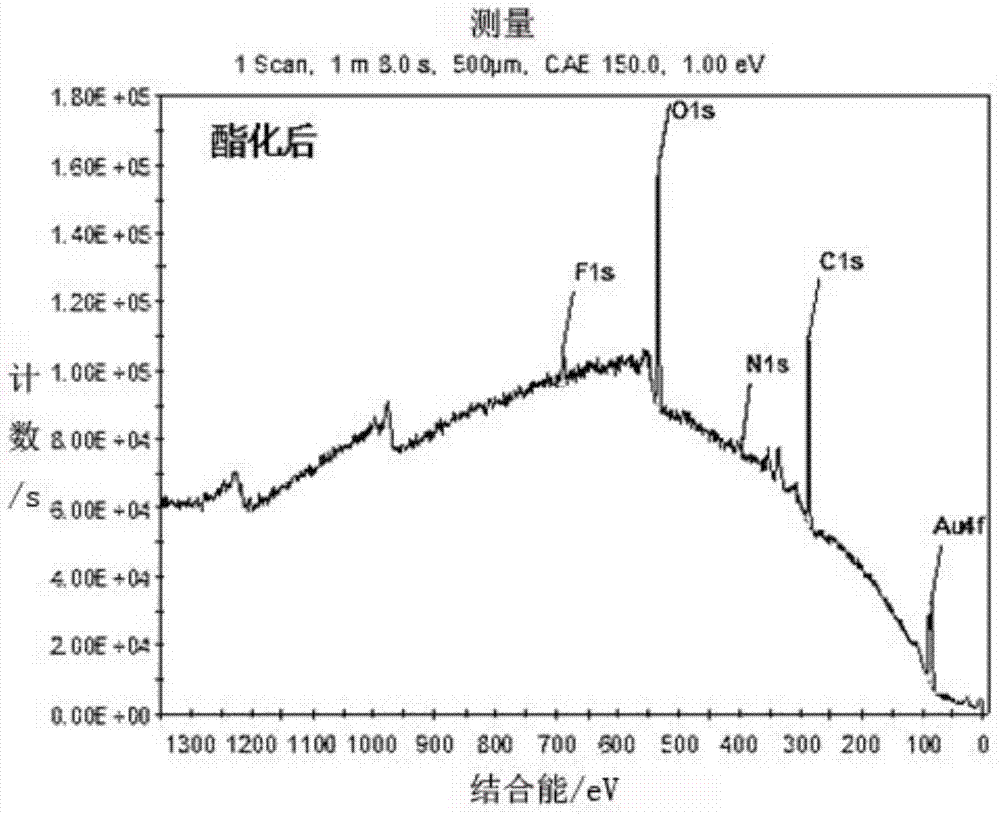A kind of small molecule microarray and preparation method thereof
A technology of small molecules and microarrays, applied in the field of small molecule microarrays and its preparation, can solve the problems of detection signal reduction, electrostatic adsorption, and increasing sources of non-specific adsorption
- Summary
- Abstract
- Description
- Claims
- Application Information
AI Technical Summary
Problems solved by technology
Method used
Image
Examples
Embodiment 1
[0074] Example 1 Preparation of Brush-like PEG Surface Small Molecule Microarray
[0075] Specific steps:
[0076] (1) A 3.5nm-thick chromium layer and a 50nm-thick gold layer were prepared on the glass substrate by thermal evaporation as the substrate of the biochip.
[0077] (2) Prepare 400 μL of monomercapto halothiol solution with a concentration of 1 mM as an initiator, prepare 400 μL of monomercapto polyethylene glycol with the same concentration, mix the two solutions at a ratio of 1:99, and spread them on the surface of the chip. Incubate at ℃ for 12 hours.
[0078] (3) Wash the gold sheet alternately with ethanol and deionized water.
[0079] (4) Preparation of monomer solution: a total of 20 mL of monomer solution, including 0.04 mM ascorbic acid, 0.04 mM copper chloride, 0.8 mM bipyridyl, 5 mM polyethylene glycol methacrylate (molecular weight 360), and methanol and water as solvents 1:1 (v / v) solvent mixture.
[0080] (5) Soak the gold flakes in the prepared ...
Embodiment 2
[0089] Embodiment 2 Preparation of hyperbranched PEG surface small molecule microarray
[0090] Specific steps are as follows:
[0091] (1) Prepare a glass substrate chip, wash and dry the chip, and then cover it with a certain amount of initiator solution.
[0092] (2) After the predetermined reaction time is reached, take out the glass and clean it.
[0093] (3) Preparation of monomer solution: a total of 20 mL of monomer solution, including 0.04 mM ascorbic acid, 0.04 mM copper chloride, 0.8 mM bipyridyl, 5 mM polyethylene glycol methacrylate (molecular weight 360), and methanol and water as solvents 1:1 (v / v) solvent mixture.
[0094] (4) Soak the gold flakes in the prepared monomer solution, and place them in an oxygen-free environment to grow polymers for 6 hours, and adjust the thickness of the polymer film by controlling the growth time.
[0095] (5) After the predetermined growth time is reached, take out the gold sheet and rinse it with ethanol and water alterna...
Embodiment 3 3
[0101] Example 3 Three-dimensional Polyrotaxane Surface Small Molecule Microarray
[0102] (1) As in step 1 in Example 1, a gold sheet was prepared as the substrate of the biochip.
[0103] (2) Prepare two ethanol solutions of mercaptopolyethylene glycol with a concentration of 1mM and different molecular weights, one is HS-(CH 2 ) 11 -EG6, the other is HS-EGn-COOH (molecular weight 2000). Mix the two solutions at a volume ratio of 10:1, put the chip into the mixed solution, and incubate at 4°C for 12 hours. After reaching the predetermined time, take it out, wash it alternately with ethanol and deionized water, and dry it with nitrogen.
[0104] (3) Immerse the chip in an aqueous solution of 128mM α-cyclodextrin (20mL) and incubate for 4 hours, then add 750mg of 1-(3-dimethylaminopropyl)-3-ethylcarbodiimide to the solution And N-hydroxysuccinimide 115mg, reaction 15min.
[0105] (4) Take out the chip, put it directly into the saturated α-cyclodextrin aqueous solution c...
PUM
| Property | Measurement | Unit |
|---|---|---|
| wavelength | aaaaa | aaaaa |
| wavelength | aaaaa | aaaaa |
| thickness | aaaaa | aaaaa |
Abstract
Description
Claims
Application Information
 Login to View More
Login to View More - R&D
- Intellectual Property
- Life Sciences
- Materials
- Tech Scout
- Unparalleled Data Quality
- Higher Quality Content
- 60% Fewer Hallucinations
Browse by: Latest US Patents, China's latest patents, Technical Efficacy Thesaurus, Application Domain, Technology Topic, Popular Technical Reports.
© 2025 PatSnap. All rights reserved.Legal|Privacy policy|Modern Slavery Act Transparency Statement|Sitemap|About US| Contact US: help@patsnap.com



